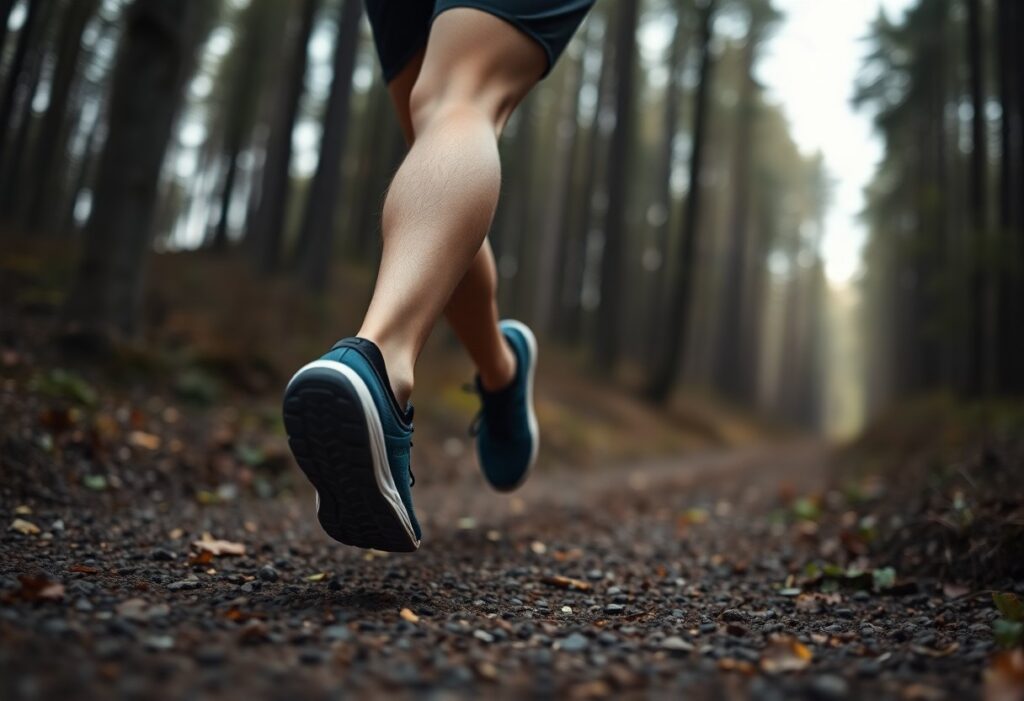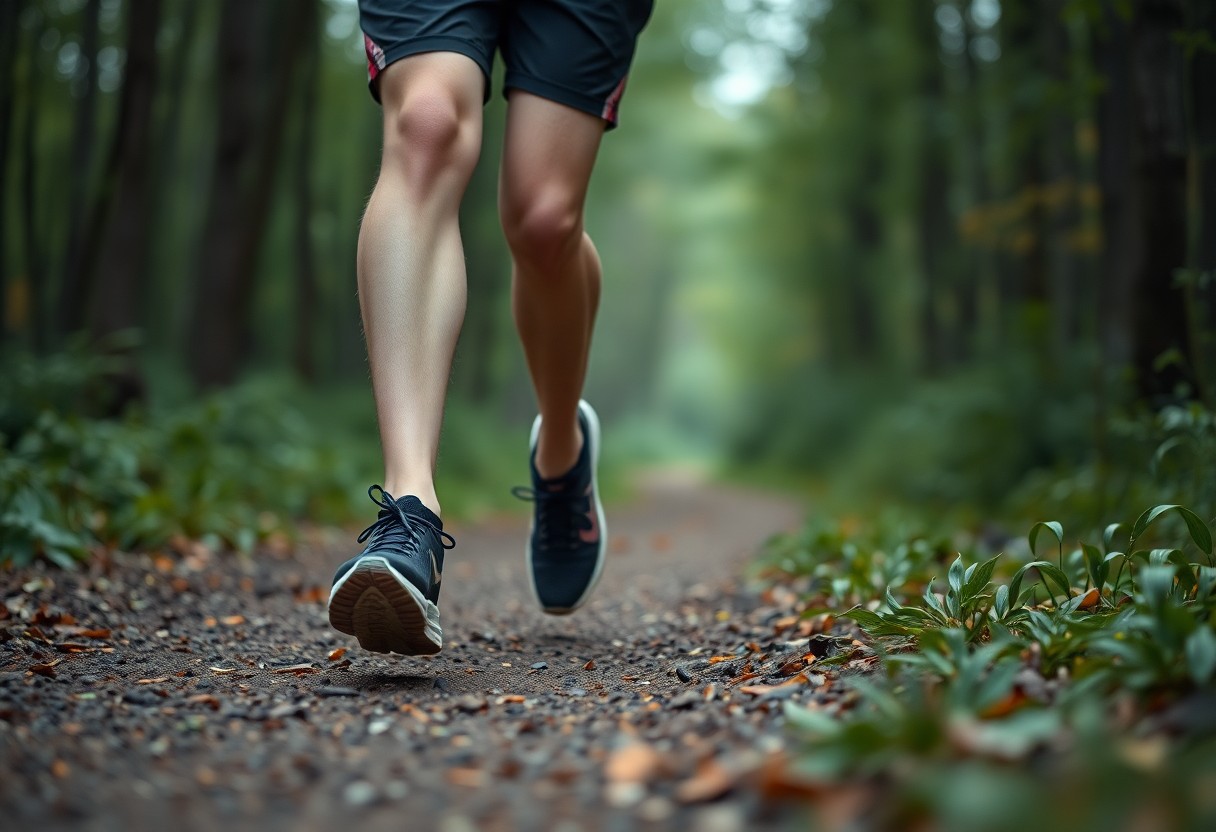
The concerning challenge of injury rates among trail runners can rise to a staggering 62% each year, often linked to the choice of unsuitable footwear. Understanding the biomechanics of minimalist footwear and its interaction with uneven terrain is vital for enhancing your performance while reducing injury risks associated with running. Implementing wearable technology can efficiently monitor critical metrics such as foot strike dynamics and load patterns, while personalised training programmes aim to strengthen foot muscles and improve endurance. This article explores how to leverage biomechanical insights and innovative technology to create effective injury prevention strategies.

Enhancing Trail Running Performance with Insightful Biomechanical Knowledge
To tackle the diverse and rugged challenges of trail running while donning minimalist footwear, it is essential to go beyond merely choosing the right shoe; it requires a profound understanding of your own biomechanics. Neglecting the specific demands that various surfaces impose can significantly increase your likelihood of sustaining an injury. As your foot strike patterns and descent mechanics fluctuate, adapting your technique becomes crucial in maintaining optimal performance and minimising potential setbacks. This knowledge empowers you to adjust your strategy on the go, ensuring that you remain both safe and efficient as you navigate the trails.
Decoding Biomechanical Foot Strike Patterns on Technical Trails
The dynamics of foot strikes can differ dramatically while traversing intricate landscapes. Runners who opt for minimalist footwear frequently exhibit a remarkable 23% higher prevalence of midfoot strikes on challenging trails, compared to just 8% seen with traditional running shoes. This adaptation not only enhances your stability on uneven surfaces but also comes with a 37% increase in metatarsophalangeal joint flexion angles, underscoring the necessity of fortifying your foot muscles to boost endurance and mitigate injury risk. Understanding these patterns enables you to tailor your training effectively, strengthening the muscles that support your running style.
Assessing the Impact of Descent Mechanics and Ground Interaction
The mechanics involved in descending from elevations are crucial in determining your performance and injury risk in trail running. Employing minimalist footwear can lead to a significant 42.191 BW/s increase in vertical loading rates on steep 15% declines, particularly in contrast to flat asphalt surfaces. Moreover, this spike in loading results in intensified lateral toe engagement — noted to be 11% greater on loose gravel than on stable surfaces, highlighting the increased demands placed on the structural integrity of your feet during descents. Recognising these dynamics can inform your approach to training and technique adjustments.
As you navigate technical trails in minimalist shoes, the biomechanics of your feet engage uniquely. The heightened vertical loading rates during descents can cause increased fatigue within your foot muscles, subsequently elevating your susceptibility to injuries. Additionally, significant alterations in toe splay patterns necessitate improved proprioception and muscle coordination, ensuring you remain responsive to the ever-changing terrain beneath your feet. By focusing on these critical factors, you can better prepare your body to meet the challenges of diverse trails, optimising your running performance for the long haul.
Unpacking the Limitations of Wearable Technology in Trail Running Performance Monitoring
Despite the transformative impact of wearable technology on the world of trail running, it introduces notable challenges in the accurate tracking of performance metrics. The variability of terrain conditions, encompassing steep descents and uneven surfaces, complicates the processes of data collection and interpretation. For example, wearable devices often struggle to provide consistent vertical oscillation measurements due to fluctuating ground conditions, which could lead to misleading insights regarding your gait and running efficiency. Understanding these limitations is crucial for making informed training decisions.
Investigating Data Accuracy Variations Among Leading Performance Tracking Devices
Significant discrepancies in data accuracy have been reported among top performance tracking devices. A study conducted in 2024 uncovered a 12.4% variance in power measurements on 10% inclines between the Stryd and GARMINRP devices, despite both demonstrating high intra-device reliability (ICC=0.89). Such inconsistencies can lead to misleading perceptions regarding your training load and overall performance, which may inhibit your ability to optimise your trail running capabilities. A critical understanding of these discrepancies is essential for making adjustments to your training approach.
and GARMINRP devices, despite both demonstrating high intra-device reliability (ICC=0.89). Such inconsistencies can lead to misleading perceptions regarding your training load and overall performance, which may inhibit your ability to optimise your trail running capabilities. A critical understanding of these discrepancies is essential for making adjustments to your training approach.
The Repercussions of Miscalculating Training Loads on Performance and Health
Miscalculations in training loads can escalate by as much as 23% on mixed-terrain routes, directly affecting your risk of injury and the progression of your performance. This problem often arises from inaccurate data interpretations during technical descents or uneven terrains, forcing you to rely on potentially flawed metrics. Such discrepancies could lead to overtraining or inadequate load management, significantly heightening your chances of sustaining an injury while running. By being aware of these potential errors, you can take proactive steps to mitigate the risks involved.
When navigating complex trail surfaces, the gap between measured and actual exertion can distort your training insights. If your device underreports your exertion, you might unknowingly push past your limits, resulting in increased fatigue and extended recovery times. Conversely, if your training load is overestimated, you may adopt a more cautious approach, inadvertently hindering your performance gains. Therefore, ensuring that your wearable technology informs rather than misleads your training strategy is vital for maintaining both your performance levels and overall health within the dynamic realm of trail running.
Examining Gender Dynamics in Trail Running Biomechanics for Enhanced Performance
Acquiring a thorough understanding of the biomechanical differences between male and female trail runners can significantly enhance performance while reducing injury risks. Research indicates that anatomical and physiological differences influence shoe selection, gait patterns, and susceptibility to injuries. Customising footwear and training programmes to account for these gender dynamics fosters safer and more effective outdoor running experiences, enabling both male and female runners to reach their full potential.
Exploring Gender-Specific Biomechanical Responses Post-Exercise
After exercise, female runners have demonstrated a 19% increase in lateral forefoot pressures compared to their male counterparts following 5km barefoot runs. Furthermore, they exhibit a 22% reduction in navicular drop during 50km ultra-marathons, indicating that their biomechanical adaptations to trail running are notably distinct. Recognising these patterns is essential for improving footwear design that accommodates the unique biomechanics of female runners, ensuring their comfort and performance on the trails.
Implementing Gender-Specific Tailored Solutions for Enhanced Trail Running
To effectively address the unique biomechanics of female runners, it is imperative to implement customised solutions that take into account their specific physical characteristics. Tailoring training programmes, utilising gender-appropriate footwear, and enhancing strength regimens can significantly diminish injury rates while simultaneously boosting running performance. For instance, incorporating exercises that focus on intrinsic foot muscle endurance and stability may prove particularly beneficial for women, who often experience different loading patterns on technical terrains. Such targeted training approaches enable all runners to optimise their performance and safeguard their health.
By analysing data from various studies and integrating findings on gender-specific responses, you can better focus on training and footwear that actively support your unique biomechanics. For example, utilising targeted strength training regimens that enhance the lower leg and foot can assist your body in adapting to the increased demands of trail running, particularly for women who frequently face elevated pressure in the forefoot area. Selecting shoes specifically designed for your unique foot mechanics can also help in addressing common injuries, ultimately fostering a more rewarding and sustainable trail running experience.

Utilising Innovative Technologies for Real-Time Gait Analysis to Enhance Safety
Your running performance and safety can greatly benefit from the implementation of real-time gait analysis using advanced technological methods. By employing integrated systems and wearable devices, you gain immediate insights regarding your foot strike patterns, body mechanics, and overall movement efficiency. These sophisticated tools are designed to provide actionable feedback while you are actively on the trail, enabling you to dynamically adjust your technique and avert repetitive strain injuries often associated with improper running form.
Understanding the Significance of Embedded Sensors in Injury Prevention
Embedded sensors within footwear play a crucial role in the prevention of injuries. They continuously monitor your foot strike patterns and pressure distributions in real time, allowing for immediate corrective feedback. This cutting-edge technology enables you to pinpoint deviations from optimal running mechanics before they escalate into serious injuries. With a mere 19-millisecond latency in ground contact alerts, you will receive timely notifications that assist you in maintaining alignment with biomechanical standards essential for avoiding injuries.
Longitudinal Studies Showcasing the Effectiveness of Biometric Feedback Technologies
Longitudinal studies reveal significant improvements in injury rates among trail runners who utilise biometric feedback technologies. Over a six-month period, athletes experienced a 37% reduction in aberrant loading patterns due to consistent monitoring and adjustments informed by real-time data. This compelling evidence underscores how sustained engagement with these technologies can enhance your running economy and resilience, thereby decreasing the likelihood of injuries related to gait abnormalities. Such proactive measures are becoming increasingly vital in the realm of trail running.
For example, a comprehensive study involving 250 trail runners documented the effectiveness of wearable sensors in identifying patterns that can lead to overuse injuries. Runners who actively engaged with feedback systems reported a 30% lower incident rate of common injuries such as plantar fasciitis and Achilles tendinitis compared to those who relied exclusively on traditional training methods. The emphasis on continuous tracking, paired with targeted adjustments based on data insights, highlights a trend towards a more proactive approach to injury prevention within trail running.
Final Thoughts on Optimising Trail Running Through Biomechanical Insights
Ultimately, comprehending the biomechanics of trail running in minimalist footwear is essential for maximising your performance while minimising the risk of injury. By seamlessly integrating wearable technology and adopting customised training methodologies, you can significantly improve both your foot strength and adaptability to various terrains. Regularly verifying metrics from different devices and monitoring your gait using advanced tools will enable you to personalise your training regimen effectively. This comprehensive approach not only supports your running journey but also encourages sustainable practices in your outdoor pursuits.
The Article Trail Running Biomechanics in Minimalist Footwear: Integrating Wearable Technology and Injury Prevention Strategies appeared first on My Shoes Finder
The Article Trail Running Biomechanics: Injury Prevention with Minimalist Shoes Was Found On https://limitsofstrategy.com







